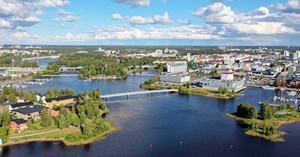District heating decreased electricity consumption
The rising electricity prices accelerated the Alajoki family’s, who live in a 200-square-metre detached house, plans to replace their electric heating system with district heating. Prior to replacing their heating system, their electricity consumption for domestic electricity and heating was over 30,000 kWh per year in a monitoring period of ten years.
In February 2022, the four-person Alajoki family, who live in Jääli, Oulu, became aware that their electricity bill had more than doubled.
“Last February was a turning point. Our electricity invoice was more than EUR 2,600 for a two-month period under exchange electricity. We immediately started to look into what we should do to get the costs down as much as possible. Our annual electricity bill at 30 cents per kilowatt hour would be around EUR 11,000, which is an unsustainable amount,” Pasi and Minna relate.

Minna and Pasi Alajoki replaced their heating system in June 2022.
Now, the electricity consumption in the Alajoki family’s detached house, which has been using district heating during the last six months, has decreased to 5,000–6,000 kWh annually.
According to the family, replacing the heating system was in itself a fast and inexpensive process, which has resulted in the family’s electricity consumption falling to a quarter to that of the previous year.
“The payback period for replacing the heating system at these electricity prices is approximately two and a half years.”

Reference data on the Alajokis’ electricity use from the Oomi customer portal (24/01/2023).
Heating system replacement on the horizon—after careful comparison, they chose district heating
Minna, who works in financial administration, and Pasi, who has worked in the construction industry for more than 30 years, mainly compared the properties of ground source and district heating.
“We ended up choosing district heating because the initial costs for a house of this size were clearly lower than that of ground source heating. In addition, the district heating equipment needs significantly less space, not to forget the operating life of the equipment to the benefit of district heating.”
Pasi’s long experience in the construction industry was reflected in the process, as he was already familiar with the technical properties of district heating.
“For example, the heat exchangers used in district heating have evolved enormously in recent years and there are hardly any differences in the features of district heating and ground source heating.”
Modern heat exchangers provide a building with constant hot domestic water and recirculating water for underfloor heating and keep the ventilation system operational in all weather conditions.

Modern heat distribution centres take up only a fraction of the utility room.
“In properties with district heating, the fact that the ventilation system stays unfrozen is one of the most significant benefits of district heating. In our case, one circuit from the three-circuit heat exchanger is connected to the ventilation system, which means that water can be directed to the ventilation system as the temperature it needs in order to stay in operation. When the ventilation system is operational even in the coldest frosts, the air quality always stays good at minimal cost. This was an important factor for us in terms of feeling comfortable at home. The inside unit is not at risk of freezing, as it is in properties where the water in the ventilation system is the same as in the underfloor heating system; such cold water does not keep the ventilation system unfrozen in freezing temperatures,” Pasi says.
Heating system replacement work started in June 2022
Pasi and Minna asked Oulun Energia for a quote for their district heating renovation, and were offered to do the whole thing as a turnkey package.
“A district heating turnkey package was a completely new concept for me despite being in the industry for a long time. I calculated it several times whether it would come out cheaper to put each step out to tender separately. However, the package was so reasonably priced that it was not worth separating the work,” Pasi shares.
The affordability of the offer was a positive surprise for the Alajoki family.
“We wondered whether it could really include everything, starting with the connection fee. We didn’t really have to think about the decision for long.”
The renovation work started in June when the earth was sufficiently unfrozen to start digging. The speedy progress was facilitated by the fact that some of the neighbouring houses were already connected to the district heating network and that the house had been made district heating-ready in 2011 when it was built.
“They listened to all our wishes during the digging and the project was completed quickly. The pipes were buried on a shared border with a neighbour, and we even got to keep our lovely hedges. The water was cut for just one morning and the whole project was finished in less than two weeks. All-in-all, the work was very good,” Minna smiles.
The carbon-neutral path of district heating an important factor
It was important for the Alajoki family that the heating they chose would also be as environmentally friendly as possible.
“That Oulun Energia’s district heating is on a path toward carbon-neutral production means, in our opinion, that it is a truly reliable choice in terms of the future, if you consider, for example, the value of the property and its possible future sale.”
“In Laanila, in Oulun Energia’s biopower plant, district heating is produced with biofuel and Solid Recovered Fuel (SRF), which reduces the price compared to heavily taxed fossil fuels,” the Alajoki family outlines.



